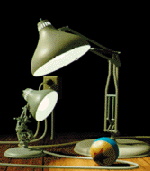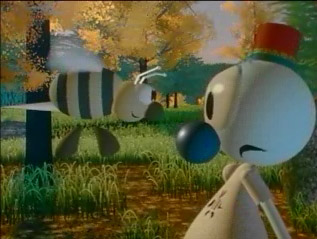Lecture 4
Lessons from
Traditional Animation 2
contains images from
www.pixar.com
www.odyssey3d.com
Lasseter, John
"Principles of Traditional Animation Applied to 3D Computer Animation,"
Proceedings of SIGGRAPH '87, Anaheim CA, pp. 35-44 - available in the
EVL Library. Please read the paper before coming to class.
- Squash and Stretch - Define rigidity and mass
of object by distorting its shape during action
- Timing - Define weight and size of objects /
personality of characters by spacing actions
- Anticipation - The preparation for an action
- Staging - Presenting an idea so it is clear
- Follow Through and Overlapping Action -
Termination of an action and establishing its relationship to the next
action
- Straight-Ahead Action and Pose-To-Pose Action
- Two contrasting appreached to creating movement
- Slow In and Out - Spacing of inbetween frames
to achieve subtlety of timing and movement
- Arcs - The visual path of action for natural
movement
- Exaggeration - Accentuating the essence of an
idea via the design and the action
- Secondary Action - The action of an object
resulting from another action
- Appeal - Creating a design or an action that
the audience enjoys watching
Squash and Stretch
- rigid objects retain shape during movement
- living flesh deforms
- volume remains constant
- hinged objects like luxo folds and extends
- very important for faces to suggest the underlying
muscles
- stretch is useful to ensure object positions overlap
when object moving quickly
Timing
- spend enough (but not too much) on preparation,
action, reaction - too much time and audience's attention will wander,
too little and the audience wont understand what happened
- determines weight of object - more massive objects
require more force to start / stop / change motion
- weight depends on spacing/timing of poses, not the
poses itself
- realism of an object depends on how it looks and
moves
- example from paper of 2 face positions with 1 to 10
in-between frames
Anticipation
- living creatures must prepare before executing an
action - walking starts with hips - the hips lead the legs, eyes lead
the head
- prepare the audience for the action that is coming
- draw the audience's attention to the right place -
then the action can be faster
Staging
- action staged to be understood, personality to be
recognizable, expression to be seen, mood to affect the audience
- audience should only see one idea at a time
- in a still scene audience attracted to movement, in a
busy seen eye attracted to stillness
- better to show action in silhouette
Follow Through and
Overlapping Action
- appendages and loose parts of an object or character
drag behind the leading parts
- heavier objects take longer to come to a stop
- people seldom complete one action before starting the
next
Straight Ahead
Action vs Pose-to-Pose Action
- straight ahead is more spontaneous, more creative
- pose-to-pose is more planned out where timing is
important
- with computer animation the computer may not do well
in interpolating the inbetweening - better to work top down through the
hierarchy
Slow In and Out
- increase the expressiveness of the keyframe poses by
timing the inbetweens so there are more towards the beginning and
ending of a motion rather than equally spacing the inbetween frames
between the two extremes.
Arcs
- straight-line paths look stiff
- arcs show the most economical route
- with computer animation the inbetween frames may
follow straight lines - may need to add a curve too it to make it more
realistic
Exaggeration
- exaggerate for enhancement of the key idea to make it
easier for the audience to understand
- dont want the exageration to be too excessive
- need to keep parts of the scene 'normal' so the
exageration stands out
Secondary Action
- highlights interest and adds realistic complexity
- facial expressions can be a secondary action - it
will be missed if it occurs during a movement
Appeal
- pleasing design and movement
- avoid twins - both arms or legs or sides of the face
in the same position
Show Luxo Jr.
(1986) and
The Adventures of Andre and Wally B. (1984) to complement the paper


Coming Next Time
General Physics
Please read the 4
pdf files before coming to class next Tuesday
last revision
9/05/06


